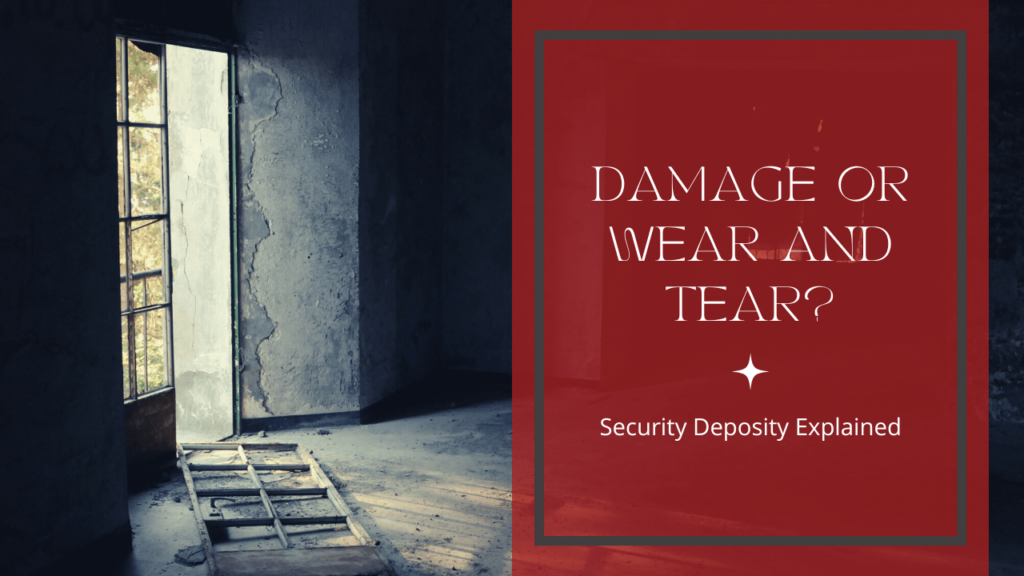Damage or Wear and Tear? Security Deposits Explained by Jacksonville Property Managers

After a tenant has moved out of your Jacksonville rental property, you’ll find yourself inspecting the home to decide what work needs to be done before it’s ready to rent again.
Will you know what you’re looking at?
It’s critical to know the difference between wear and tear, which is an owner’s responsibility, and damage, which is a tenant’s responsibility.
Sometimes, it’s pretty obvious. The finger paint on the walls and floors is definitely damage. The faded paint from direct sunlight is likely wear and tear.
There are sometimes conditions where it could go either way, and that’s when your inspection can become tricky. That’s because the amount of the security deposit that goes back to your tenant depends on your ability to distinguish between general wear and tear and property damage.
The distinction between wear and tear and tenant damage isn’t simply a matter of opinion. In Florida, we’re lucky to have a pretty landlord-friendly state. But, there are strict laws that govern how the security deposit is used and when it needs to be returned. You have to follow those laws or you may find yourself in court defending your security deposit deductions.
How do you know when you’re looking at general deterioration, and when does it become damage? We’re going to talk about some ways to avoid making any potential mistakes that could lead to tenant disputes and court claims.
How to Define Normal Wear and Tear in a Jacksonville Rental Property
You might find that it’s difficult to get an absolute definition of what wear and tear looks like in a rental property. In general, however, you can rely on this: Wear and tear is the general deterioration that happens to a property regardless of who is living there. The scuff marks on the wall where furniture was resting and the worn carpet in high traffic areas are going to happen. Wear and tear is often expected. You know there will be some signs of life being lived after tenants have occupied the home for a year or longer.
Tenants are not held accountable for these things because they’re often unavoidable. There’s little that can be done to prevent it. Paint won’t last forever.
If you’re looking for specific examples of normal wear and tear, here are some that we’ve come up with in our experience as Jacksonville property managers:
- Small nail holes in the walls from where pictures were hung.
- Loose grout between tiles, especially in the bathrooms.
- Doors or cupboards that have warped from humidity.
- Faded paint on the interior walls and exterior surfaces.
- Door frames or window frames that may have warping.
- Blinds that may have faded from sunlight.
- Scuffs or dents in walls behind doors (from door handles).
- Minor carpet staining or discoloring.
- Slight scrapes or marks on a hard floor.
- Finishes wearing away, staining or rusting.
You’ll need to fix these things during the turnover process, and it’s not fun to have to pay for fresh paint or new window blinds. But, they are ultimately your responsibility. This inevitable physical decline occurs not because of the actions of your tenants, but because everything has a lifespan and eventually the work will need to be done anyway.
The longer a tenant occupies your property, the more wear and tear can be expected. If a tenant has been in place for 10 years and the walls have not been painted in that entire decade, you’re going to expect that you’ll have to repaint before a new tenant moves in. You’ll likely need to install new carpet or flooring and update your appliances and fixtures.
Long-term tenancies are good for your bottom line, but there may be more work to be done when that long-term tenant finally moves out. Prepare for this in terms of budget and the amount of time you’ll have to spend preparing your property for the rental market again.
How to Identify Property Damage in a Jacksonville Rental Home
Property damage is different.
It’s the reason you collect a security deposit when Jacksonville tenants are moving into your home.
It’s not always intentional, but the damage is what goes beyond wear and tear. It harms the value, usefulness, or normal functioning of your rental property.
Damage can be a baseball that was tossed through a window, breaking it. Damage might be entire pieces of floor missing or scratched up. Giant stains on the carpet. This is not natural deterioration.
To use the security deposit money to pay for the damage you’ve identified, you must be able to document that the damage occurred during the tenancy. This is why we are so careful with our move-in and move-out inspections. They provide the documentation you need.
Examples of property damage may include:
- Large holes in the walls or floors.
- Changes to the property, such as different paint colors that were not pre-approved.
- Tears, stains, or holes in the carpet.
- Water stains on wood floors.
- Broken appliances, doors, or windows due to abuse.
- Missing or cracked bathroom tiles and mirrors.
- Writing on walls, floors, and surfaces.
- Yards or gardens that have been destroyed due to animals, cars parked on them, or excessive trash.
When you’re withholding money from the security deposit to pay for these things, document the amount you’re spending and why. You’ll need to provide an itemized list to your tenant that explains why they aren’t getting the full deposit back – or any deposit at all.
Florida Security Deposit Laws and Tenant Damage
Before you decide what you can and cannot deduct from your tenant’s security deposit based on your decisions about what qualifies as damage and what is simply wear and tear, you need to understand some important legal timelines.
Florida law requires you to return the tenant’s security deposit within 15 days of move-out if you’re not making any claims on the security deposit. When your tenant moves out and you can’t find any damage to deduct for, send the full deposit back immediately.
If you do need to make deductions, you’ll have longer than 15 days and even up to 60 days after the tenant has moved out of the rental property.
Send a written notice to the tenant within 30 days explaining your deductions and your intention to keep part or all of the deposit. If you cannot get the work done and paid for right away, you can send estimates within 30 days and then final copies of repair invoices within 60 days. The important thing to remember is that you must itemize every repair for damage and show what you’ve paid for it.
Property owners who fail to provide this written statement are essentially granting tenants a great reason to dispute the charges and go to court. When you cannot document or defend every deduction you make to a tenant’s security deposit, you may find yourself legally required to return the full deposit and pay some additional penalties.
Send the security deposit and/or the itemized written list to the tenant’s last known address.
Inspections Help Define Wear and Tear and Damage
You can have a great experience with a resident and then find yourself arguing over the security deposit at the end of the lease term. If there’s going to be a conflict between owners and renters, it’s likely going to show up when tenants expect to get a full refund and owners have a list of the things they believe their tenants are responsible for. It can get uncomfortable, and it reminds us that good documentation is essential.
Avoid tenant disputes by taking in-depth photos of the property before they move in. You’ll want to account for every wall, floor, ceiling, and surface. It’s hard to argue with photos. Make sure your inspection report is thorough, signed by the tenants, and filed away for the end of the lease term. Just when you think you’ve added too much detail – add a little more.
Conduct a similar inspection after your tenants move out. This is where you’ll document the damage. Take exhaustive pictures. Make detailed notes. There should be no doubt that the damage is real and caused by your tenants. It’s the only way to avoid a legal battle or a dispute with your tenants.
If your tenant pushes back against what you’re charging, invite them to look at the evidence with you. If you can demonstrate why you’ve made the deductions and show pictures and videos, they might drop their complaint. If they do take you to court, however, decide how sure you are you’ll win and how much the victory is worth to you. If you’re arguing over a $100 charge, it might be in your best interests not to keep fighting for that $100. A court case could cost you more.
No one likes to argue with tenants about wear and tear and damage. If you’d like some help ensuring you are correct about identifying wear and tear versus tenant damage, please contact us at Red Rooster Property Management. We have a lot of experience when it comes to security deposits and rental homes in Jacksonville, Orange Park, St. Johns, and the surrounding communities.

